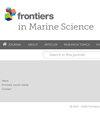不同河流输入和浮游植物群落季节变化对沿海泻湖硝酸盐循环的影响
IF 3
2区 生物学
Q1 MARINE & FRESHWATER BIOLOGY
引用次数: 0
摘要
河口系统处于陆地和海洋环境的交界面,由于其输入量大、滞留时间长、生物地球化学活性高,是硝酸盐(NO3 -)滞留和处理的重要场所。然而,海洋和底栖过程如何控制NO3 -循环以及这些过程的相对重要性如何受到河口条件季节性变化的影响仍不确定。我们测量了库尔斯泻湖(波罗的海东南部)在春季和夏季两个时间段内控制NO3 -循环的一系列过程。结果表明,在春季,底栖生物的同化和异化过程占主导地位,而在夏季,中上层生物的同化过程占主导地位。在春季,温度升高和河流氮输入与硅藻华的发生有关。硅藻对氮的同化作用导致颗粒有机氮和有机质向底栖生物输送,导致沉积物反硝化作用增强,水体向沉积物输送NO3 -。在夏季,浮游植物大量繁殖的浮力蓝藻和高同化吸收率占主导地位,导致更多的颗粒有机氮从泻湖出口到海洋。在夏季溶解无机氮浓度较低的情况下,较高的吸收量表明远洋生物群落具有高效利用多种形态氮的营养策略。总体而言,我们的研究结果表明,硅藻主导的群落促进了强烈的底栖-远洋耦合,而蓝藻主导的群落则与基于远洋的氮循环有关。虽然这项研究揭示了库尔斯泻湖NO3 -滞留的机制,但建议进一步的时空分辨率来更好地代表速率的变化,并包括其他波罗的海泻湖,以全面了解浅河口系统的N循环。本文章由计算机程序翻译,如有差异,请以英文原文为准。
The effects of variable riverine inputs and seasonal shifts in phytoplankton communities on nitrate cycling in a coastal lagoon
Estuarine systems, being situated at the interface between land and marine environments, are important sites for nitrate (NO3 – ) retention and processing due to large inputs, long retention time, and high biogeochemical activity. However, it remains uncertain how pelagic and benthic processes control NO3 – cycling and how the relative importance of these processes is affected by seasonal changes in estuarine conditions. We measured the suite of processes governing NO3 – cycling in the Curonian Lagoon (Southeast Baltic Sea) during two time periods representing spring and summer conditions. We show that in spring, benthic dissimilatory and assimilatory NO3 – processes prevailed, while in summer, pelagic assimilatory processes dominated. During spring, warming temperatures and riverine nitrogen (N) inputs were associated with the onset of diatom blooms. N assimilation by diatoms resulted in the delivery of particulate organic N and organic matter to the benthos, resulting in greater denitrification in the sediments and a flux of NO3 – from the water column to the sediments. In summer, phytoplankton blooms of buoyant cyanobacteria and high rates of assimilatory uptake dominated, resulting in greater particulate organic N export from the lagoon into the sea. Given the low dissolved inorganic N concentrations in summer, high uptake indicates that the pelagic community possessed a nutritional strategy to efficiently utilize multiple N forms at high rates. Overall, our findings show that diatom-dominated communities foster strong benthic-pelagic coupling, whereas cyanobacteria dominance is associated with pelagic-based N cycling. While this study sheds new light on mechanisms of NO3 – retention in the Curonian Lagoon, further spatiotemporal resolution is recommended to better represent the variability in rates and to include other Baltic lagoons for a comprehensive understanding of N cycling in shallow estuarine systems.
求助全文
通过发布文献求助,成功后即可免费获取论文全文。
去求助
来源期刊

Frontiers in Marine Science
Agricultural and Biological Sciences-Aquatic Science
CiteScore
5.10
自引率
16.20%
发文量
2443
审稿时长
14 weeks
期刊介绍:
Frontiers in Marine Science publishes rigorously peer-reviewed research that advances our understanding of all aspects of the environment, biology, ecosystem functioning and human interactions with the oceans. Field Chief Editor Carlos M. Duarte at King Abdullah University of Science and Technology Thuwal is supported by an outstanding Editorial Board of international researchers. This multidisciplinary open-access journal is at the forefront of disseminating and communicating scientific knowledge and impactful discoveries to researchers, academics, policy makers and the public worldwide.
With the human population predicted to reach 9 billion people by 2050, it is clear that traditional land resources will not suffice to meet the demand for food or energy, required to support high-quality livelihoods. As a result, the oceans are emerging as a source of untapped assets, with new innovative industries, such as aquaculture, marine biotechnology, marine energy and deep-sea mining growing rapidly under a new era characterized by rapid growth of a blue, ocean-based economy. The sustainability of the blue economy is closely dependent on our knowledge about how to mitigate the impacts of the multiple pressures on the ocean ecosystem associated with the increased scale and diversification of industry operations in the ocean and global human pressures on the environment. Therefore, Frontiers in Marine Science particularly welcomes the communication of research outcomes addressing ocean-based solutions for the emerging challenges, including improved forecasting and observational capacities, understanding biodiversity and ecosystem problems, locally and globally, effective management strategies to maintain ocean health, and an improved capacity to sustainably derive resources from the oceans.
 求助内容:
求助内容: 应助结果提醒方式:
应助结果提醒方式:


